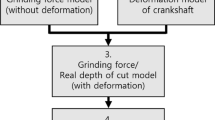Abstract
To ensure the installation precision of grinding wheel in precision grinding, the attitude of spindle axis must be adjusted to coincide with the geometric center of grinding wheel before the process. A special device that combined with piezoelectric actuators with three-degrees-of-freedom is designed. The corresponding method of automatic compensation technology for eccentricity of grinding wheel is developed. In order to calculate accurately eccentric angle and the eccentricity of the grinding wheel, high accuracy detection algorithm for eccentric signal of grinding wheel is given by the principle of rotary roundness error minimization firstly. Then a decomposition algorithm is proposed to decompose the eccentricity into three directions and the eccentricity can be eliminated by the coordinated control of the three piezoelectric actuators. Experimental results show that the average accuracy of the system is about 5.48 μm. Compared with the sine fitting algorithm, the algorithm presented for adjusting the eccentricity of grinding wheel in this paper is more stable and the accuracy is improved by about 78.2%, which shows that the proposed approach works successfully.
Similar content being viewed by others
References
Singleton, R., Marshall, M. B., Lewis, R., and Evans, G., “Rail Grinding for the 21st Century-Taking A Lead from the Aerospace Industry,” Proceedings of the Institution of Mechanical Engineers, Part F: Journal of Rail and Rapid Transit, Vol. 229, No. 5, pp. 457–465, 2015.
Hmaidouch, R., Müller, W.-D., Lauer, H.-C., and Weigl, P., “Surface Roughness of Zirconia for Full-Contour Crowns after Clinically Simulated Grinding and Polishing,” International Journal of Oral Science, Vol. 6, No. 4, pp. 241–246, 2014.
Tian, Y., Wang, Y., Wang, L., and Zhao, W., “The Centering and Leveling Adjustment and Control Technology for the Ultra-Precision Turntable,” Proc. of SPIE, Vol. 9618, 2015.
Su, J. and Gao, B., “Design of Non-Contact Balance Head for Grinding Wheel,” Advanced Materials Research, Vols. 201–203, pp. 557–560, 2011.
Fan, H., Jing, M., Wang, R., Liu, H., Xin, W., and Zhi, J., “Design, Calculation and Response Experiment of an Automatic Electromagnetic Balance,” Journal of Vibration, Measurement & Diagnosis, Vol. 34, No. 5, pp. 807–811, 2014.2
Xin, P., Haiqi, W., Jinji, G., and Weimin, W., “New Liquid Transfer Active Balancing System Using Compressed Air for Grinding Machine,” Journal of Vibration and Acoustics, Vol. 137, No. 1, Paper No. 011014, 2015.
Liu, Z., Wen, J., and He, T., “Application of Adaptive Filtering Based on Harmonic Wavelet in the Dynamic Unbalance of Electro-Spindle,” Proc. of International Conference on Measuring Technology and Mechatronics Automation (ICMTMA), pp. 597–600, 2010.
Jain, R., Majumder, S., Ghosh, B., and Saha, S., “Deflection Control for Piezoelectric Actuator through Voltage Signal and It’s Application in Micromanipulation,” Mechanical Systems and Signal Processing, Vols. 62–63, pp. 305–323, 2015.
Li, Y., Baker, R. J., and Raad, D., “Improving the Performance of Electrowetting on Dielectric Microfluidics Using Piezoelectric Top Plate Control,” Sensors and Actuators B: Chemical, Vol. 229, pp. 63–74, 2016.
Dong, R., Tan, Y., and Xie, Y., “Identification of Micropositioning Stage with Piezoelectric Actuators,” Mechanical Systems and Signal Processing, Vol. 75, pp. 618–630, 2016.
Liu, C. H. and Jywe, W.-Y., “A Four-Degrees-of-Freedom Microstage for the Compensation of Eccentricity of a Roundness Measurement Machine,” International Journal of Machine Tools and Manufacture, Vol. 44, No. 4, pp. 365–371, 2004.
Kuhnen, K. and Janocha, H., “Adaptive Inverse Control of Piezoelectric Actuators with Hysteresis Operators,” Proc. of European Control Conference (ECC), pp. 791–796, 1999.
Dhanish, P., “A Simple Algorithm for Evaluation of Minimum Zone Circularity Error from Coordinate Data,” International Journal of Machine Tools and Manufacture, Vol. 42, No. 14, pp. 1589–1594, 2002.
Author information
Authors and Affiliations
Corresponding author
Rights and permissions
About this article
Cite this article
Chen, SP., Wang, ZZ., Yu, H. et al. Research on Automatic Compensation Technology for Eccentricity of Grinding Wheel. Int. J. Precis. Eng. Manuf. 19, 1201–1209 (2018). https://doi.org/10.1007/s12541-018-0141-9
Received:
Revised:
Accepted:
Published:
Issue Date:
DOI: https://doi.org/10.1007/s12541-018-0141-9




